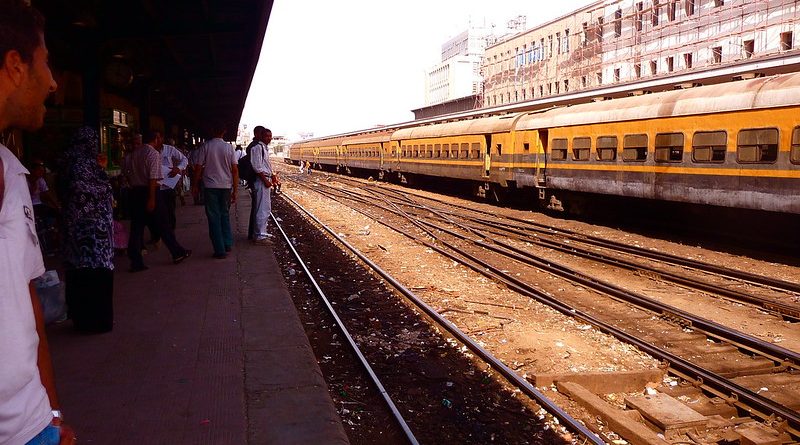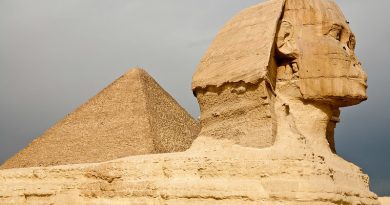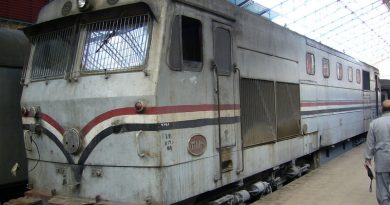Tough Trains of Africa: Egypt and Sudan
EGYPT
The first railway in Egypt and the first on the African continent was between Alexandria and Cairo in 1852 and opened throughout in 1856. Today the State Railways have a system that possesses some 642 locomotives, 1,579 carriages 14,339 wagons, and numerous other vehicles. They also have a terrible reputation for safety.
Start location:
Cairo
Ramses Railway Station is the main railway station of Cairo, Egypt. The name is derived from the Ancient Egyptian pharaoh Ramses II whose statue was erected by Nasser on the square in 1955. The station was formerly known as Misr Station.
The original railway station was built as the terminal of the first rail link from Alexandria to Cairo in 1856. The current building was erected in 1892 and upgraded in 1955. As of January 2001 it was undergoing a major modernisation. In early 2011, following the Egyptian Uprising, Ramses station was fully upgraded and air conditioned with new marble flooring across the station and the addition of escalators. Some critics believe that the modernisations were too modern and destroyed much of the building’s original style.
Outside of the station used to be the statue of Ramses II that was relocated to Memphis, Egypt, 12 miles (19 km) south of Cairo in the area of Giza on 25 August 2006.
There are several classes of trains in Egypt, but tourists aren’t technically allowed on the local ‘ordinary’ train. Board it anyway and you’ll be unlikely to be kicked off.It’s possible to travel by train all the way from Cairo to Aswan .
Aswan
Aswan, formerly spelled Assuan, is a city in the south of Egypt, the capital of the Aswan Governorate. Aswan is a busy market and tourist centre located just north of the Aswan Dams on the east bank of the Nile at the first cataract. This is where Nubia begins.
Nubia is a region along the Nile river, which is located in northern Sudan and southern Egypt. There were a number of small Nubian kingdoms throughout the Middle Ages, the last of which collapsed in 1504, when Nubia became divided between Egypt and the Sennar sultanate resulting in the Arabization of much of the Nubian population. Nubia was again united within Ottoman Egypt in the 19th century, and within Anglo-Egyptian Sudan from 1899 to 1956.
Sudan
Sudan was once home to Africa’s largest railway network, with more than 5,000 kilometres (3,100 miles) of track running from the Egyptian border to Wau, now located in South Sudan.
Today, after decades of mismanagement and neglect, most of the country’s rail track is out of service. Combine 5 days of travel, unexpected stops and over 40 degrees in the height of summer and suddenly train travel doesn’t appeal quite so much anymore. These are the Nile’s Tough Trains.
INTO SUDAN
Egypts rich past has overshadowed Sudan’s own heritage. As early as 2300 BC the Pharisaic Kingdoms had begun to expand south. By 1000BC Nubia had become an Egyptian colony and the empire’s prime source to gold, producing an estimated peak of 40,000kg per year.
More than 3,100 miles of track once stretched from the Egyptian border to Darfur. No longer. The passenger line between the capital of Khartoum and the port outpost of Wadi Halfa in the north is the last remaining relic of what was the best railway network in Africa at the time of the country’s independence in 1956.
This line was built under Britain’s Lord Kitchener during the Anglo-Egyptian conquest of Sudan, and was crucial to the campaign against Mahdist forces. Work began under the summer sun of 1897, and progressed at a rate of around 2km a day into unsurveyed desert territory. Two trains per day ran along the unfinished track to provide the working party firstly with building materials and secondly with personal supplies and home comforts. More importantly, the railway was far quicker than the camel as a means of transporting soldiers. Six months later, the Khalifa’s forces were defeated at Atbara, and the tracks were extended into the town and onwards to Khartoum.
HALFA
The Tough Train:
The train has 1st class sleepers, 1st & 2nd class seats in compartments, and 3rd class open bench seats. It’s slow, old and basic, but should get you there give or take the odd breakdown, the desert views are enriching and the company is bound to be entertaining. It’s not air-con, so bring plenty of water as it can get very hot as the train crosses the desert.
The train to Khartoum is extremely run down, full of people (more than there were seats) as well as a huge amount of cargo which traders bribe the guards to store anywhere on the train.
They cannot travel at more than 40 kilometers an hour because the British-designed wooden sleepers and tracks, mostly laid between 1896 and 1930, are too weak.
The train to Khartoum makes several stops along the way but the longest ones (about 30 min-1hr), enough to look for a toilet, are at Abu Hamad, Atbara and Shendi.
Wadi Halfa
The town is located amidst numerous ancient Nubian antiquities and was the focus of much archaeological work by teams seeking to save artifacts from the flooding caused by the completion of the Aswan Dam.
The modern town was founded in the nineteenth century and is chiefly known as the headquarters (1895–1898) of the British-led Egyptian and British forces seeking to defeat the forces of Muhammad Ahmad, the self-proclaimed Mahdi. The rail line up the Nile was originally begun in 1897 to support this military buildup. Goods are now transferred from Sudanese rail to ferries going down the Lake Nasser.
Karima
The hill of Jebel Barkal is near Karima. Beside it are the ruins of Napata, a city-state of ancient Nubia on the west bank of the Nile River, including the temple of Amun. The Shaigiya tribe lived around Karima and Korti, but suffered for their support of the British against the Mahdi. The land around Karima is a center for cultivation of Barakawi dates. Karima is a terminus of a branch narrow gauge railway of the Sudan Railways system.
Atbara
Atbara became the hub of the Sudanese railway network and an important industrial centre. Union activity began to develop in the 1940s and four decades later, under Nimeiri’s rule, the railways were deliberately picked apart and decentralised in an attempt to crush workers’ strikes. The Sudan Railways Corporation has never really been revitalised. and the British-built bungalows and leafy avenues that make up the western half of Atbara now have a rather ghostly atmosphere
There are more pyramids in Sudan than in Egypt and over 50 pyramids sit at the necropolis of Meroe. The once royal city thrived from 592BC until it was overrun by Abyssinians in 350AD.
This was the last outpost of Nubia.
Khartoum
The 446 km long 1 067 mm gauge line was opened in March 1962 (RG 4.62 p414). Services were interrupted from 1984 during the second civil war, and in 1991 the infrastructure was destroyed by the Sudan People’s Liberation Army to prevent supplies reaching the government garrison at Wau.
Khartoum hopes to revive the rail network with Chinese aid. The government, with the help of Chinese money and expertise, wants to rebuild it and restore some of the industry’s former glory. Modernizing the railways, Khartoum hopes, will boost the export of livestock and products such as cotton and gum arabic – an edible gum taken from acacia trees and used in soft drinks and drugs. That would help support Sudan’s economy, which has been plunged into crisis by the loss of most of the country’s oil production since it split from South Sudan in 2011.
Khartoum was founded by the Egyptians in 1821. It became the capital of Sudan upon independence from the British in 1956. Khartoum is said to derive its name from the thin spit of land at the convergence of the rivers, which resembles an elephant’s trunk (khurtum). Sufi dancers, better known as whirling dervishes, perform their magic every Friday outside the Hamed al-Nil tomb in Omdurman (just south of the market).




